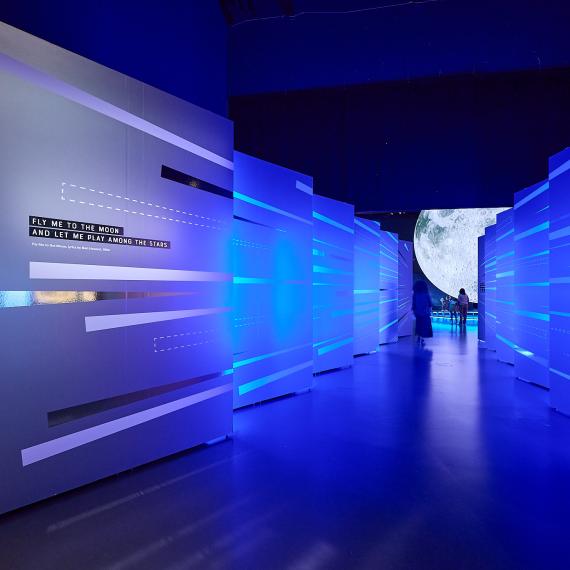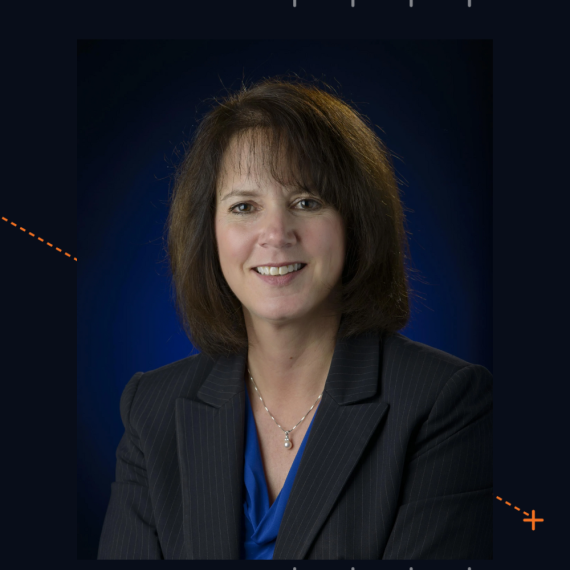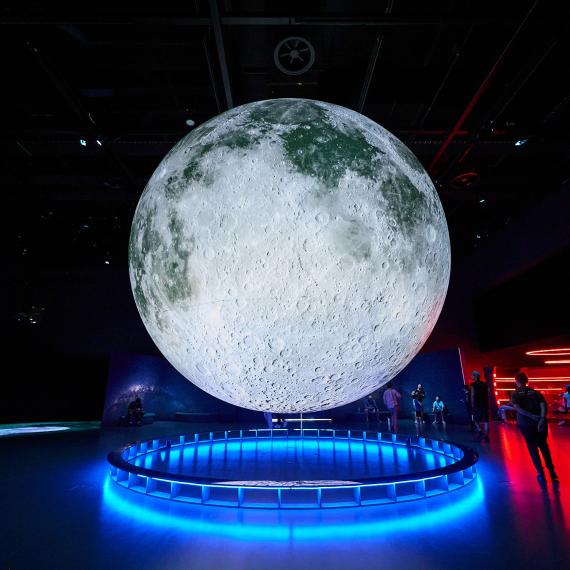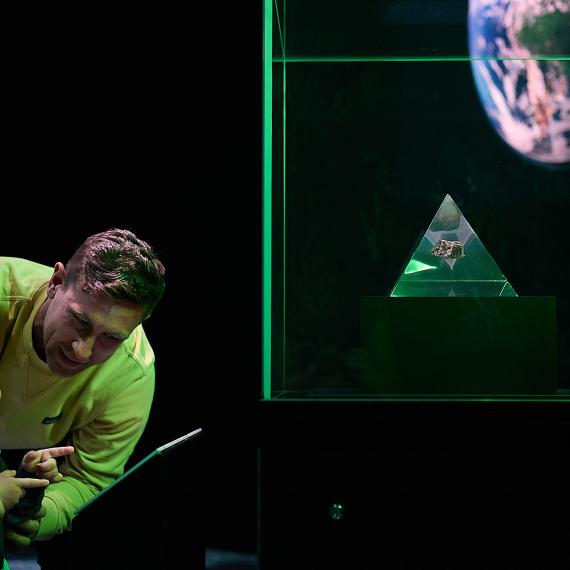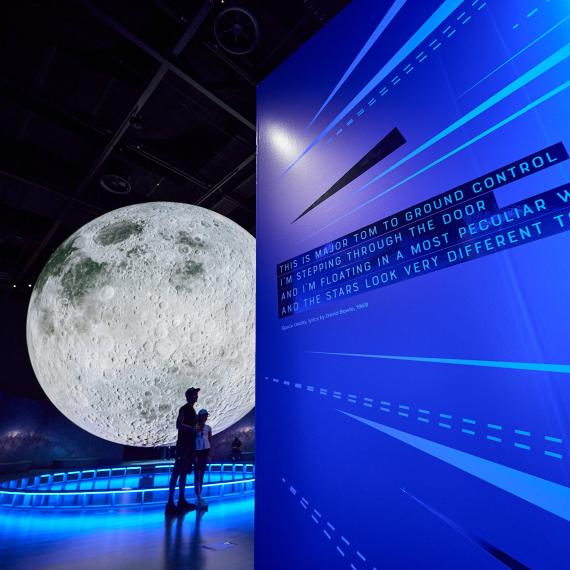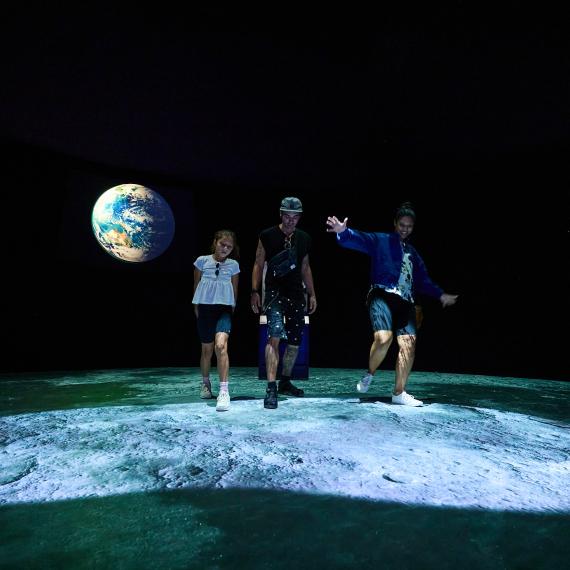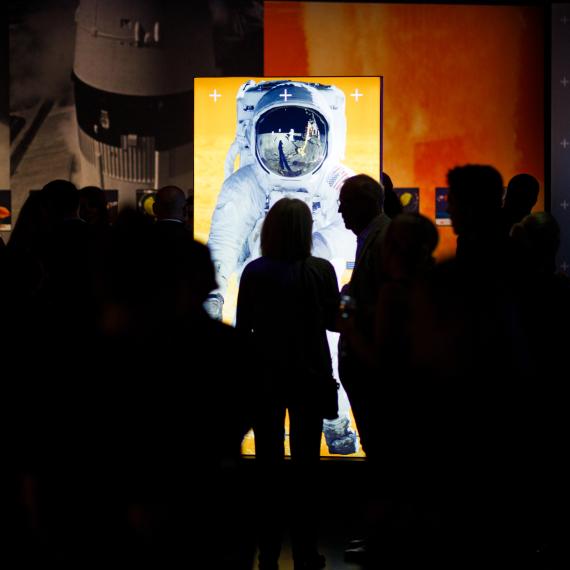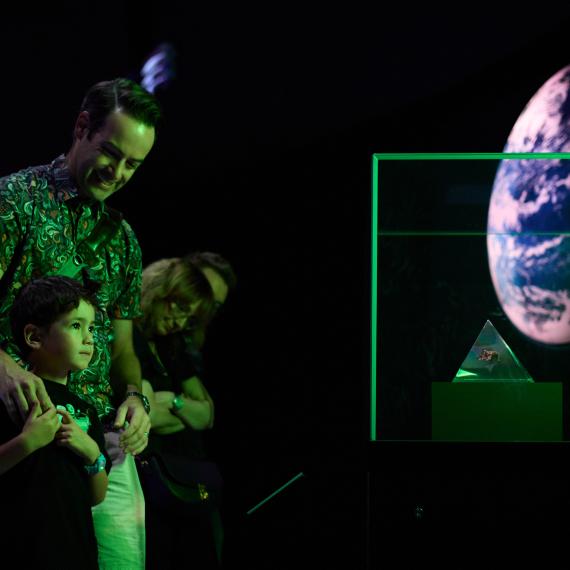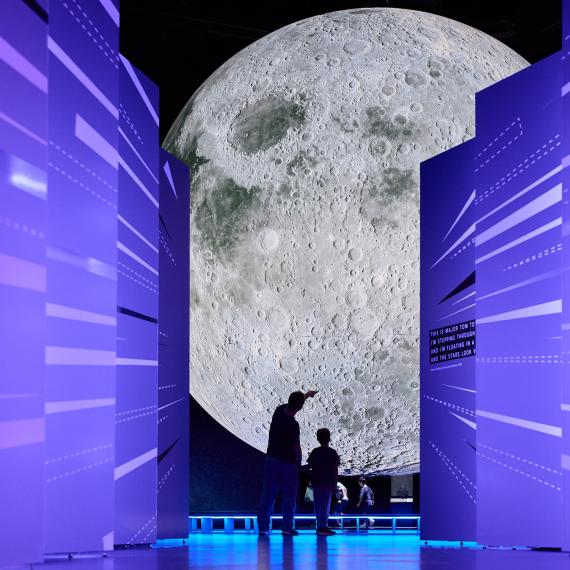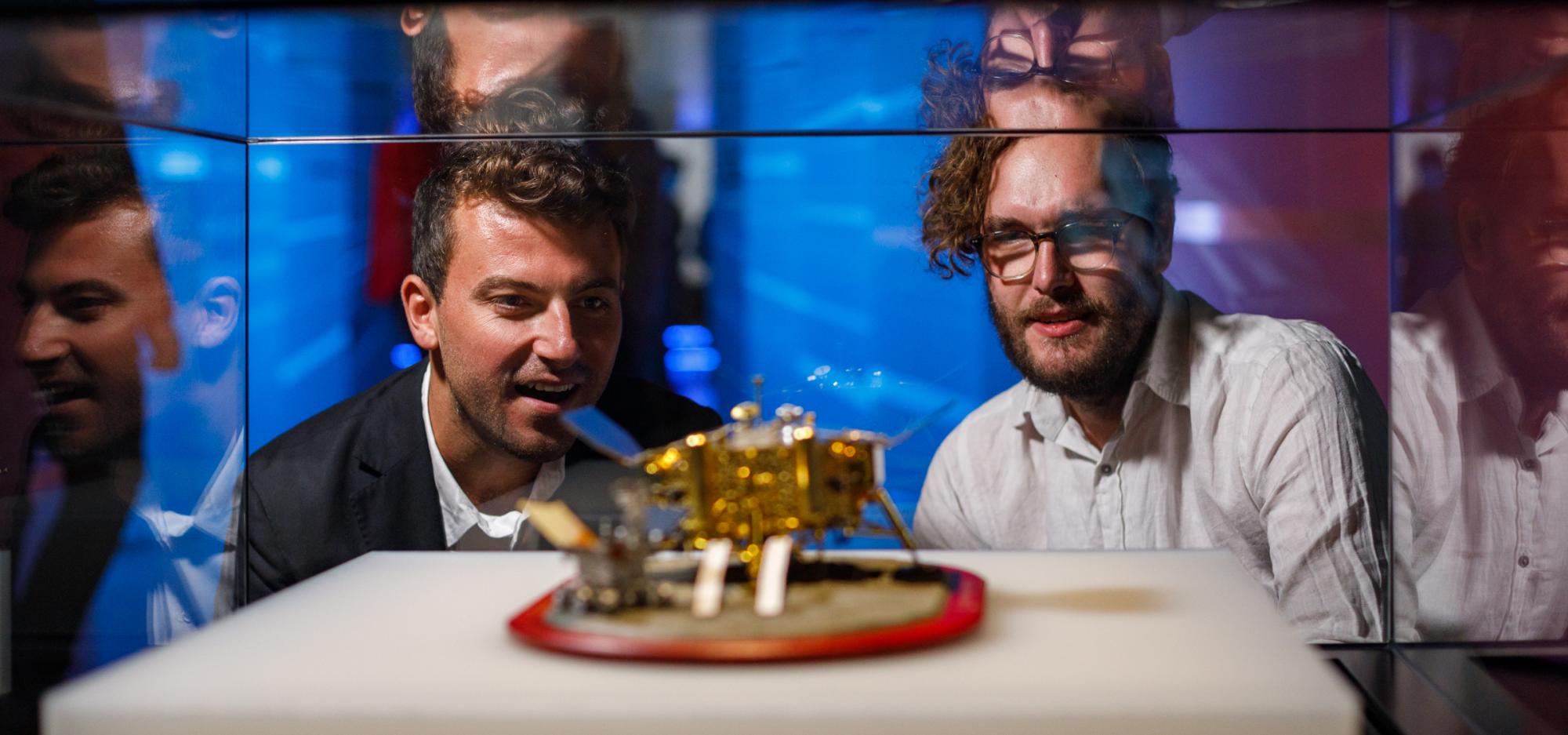
Lunar orbiter missions with Professor Phil Bland
A key element of NASAs Artemis Program is the concept of in situ resource utilisation: using local resources, rather than take everything with us from Earth. Water is the key strategic resource, both for life support and rocket fuel, but identified deposits are extremely difficult to access.
In this talk Professor Bland outlines the mission that Curtin is developing to find ice on the Moon in accessible locations.
-
Episode transcript
[Recording] You're listening to the Western Australian Museum Boola Bardip talks archive. The WA Museum Boola Bardip hosts a series of thought-provoking talks and conversations tackling big issues, questions and ideas. The talks archive is recorded on Whadjuk Nyoongar Boodjar. The Western Australian Museum acknowledges and respects the traditional owners of their ancestral lands, waters and skies.
MC: Hello. Yes, hello. Good evening everybody and welcome to the WA Museum Boola Bardip and the To The Moon Exhibitions and the Luna Lounge event. Before we begin I'd just like to take a moment to acknowledge the land on which we're gathered on and learning here tonight, the lands of the Whadjuk People of the Nyoongar Nation. And may we pay our respects to elders, past and present, and extend those respect to any First Nations people here with us tonight.
So, this evening we are joined by Professor Phil Bland, who over the next 30 minutes is going to be taking us through lunar orbital missions with a short Q&A at the end. So if you've got any questions, please save them for the end. So please make Professor Phil Bland feel welcome.
PB: Hi folks, thanks so much. Before I start I'd also like to recognize the traditional owners of the land. And, we have a particular connection there. A lot of the work that we've done in the past has been in relation to a project that we did called The Desert Fireball Network, where we're tracking meteorite fireballs coming through the atmosphere. And we named our spacecraft engineering program after the Nyoongar word for fireball, which is Binar, and so that's why it's called The Binar Space Program. That's the Nyoongar word for fireball. And before I go any further, I will just introduce Professor Gretchen Benedix who is a very renowned professor of planetary science, also my wife. So if you hear heckling then you know that she's a ringer.
So, what I'm going to tell you about tonight is the project that we've been doing, which is spacecraft engineering happening right here in WA. A program that is built by all WA young engineering graduates. And, as you know, the person who's been trying to organize and just guide these amazing people, it's been a great pleasure to kind of see them all come up from undergrads and even high school students up to, like, now, actually building spacecraft. So, this is just a little introduction with the Space Science Technology Center, Curtin University. That's where we all do our stuff. We've been on, scientists in our team have been on all of the missions that you see there. So there's been WA representation on all of those space missions, which means basically that we've been working with other scientists and teams from all of those space agencies, representing our state , on all of those space missions. And some of those have now got, some of our engineers worked on projects that where there's actually hardware on the surface of Titan, or Mars. And actually that's the Beagle 2 lander, which was a British mission, which was the first mission that I was involved in, and it didn't work. And we thought for a long time that it was the first British crater on Mars, but it did actually land and didn't make a crater. So that was good. So, the first mission that I've been involved in, kind of from almost from start to finish, is called the Osiris-Rex and it's an asteroid sample return mission.
So NASA sent a space probe to this asteroid, grabbed a sample, brought it back to us and we're actually analyzing that material right now in the labs at Curtin. And I was lucky enough to be there to watch it launch. I was there with Gretchen and our kids. The kids are really not that impressed. I mean, what do you have to do? Right? So, this is an artist's representation of the spacecraft at the asteroid that we visited. And it was just an amazing moment. So when you're part of a space mission, you kind of get a behind the scenes look at what's happening, you know, in Mission Control at that time. And there's all your colleagues who are just, it was during Covid so they've all got masks on, but they're just, you know, glued to the screen as the space probe is sending back data, saying okay, I know where I am to within like 50cm, 60cm, 70. And if it goes above a meter then, you know, it can actually crash into a boulder and everything's finished. So everyone is just kind of, you know, on tenterhooks until they've grabbed the sample and that was an amazing moment.
So what I wanted to get into really and talk mostly about is the space program that we're doing here in WA. And this kind of comes from, so I've been in WA for 12 years. We moved here from London, and got my citizenship three years ago, and proudest moment in my life, I'm a very proud West Australian. And I just want to do as much as I can to kind of, you know my bit, to make, I mean all right not everyone in WA is desperate to see more planetary science happen. But I think if we can, if we can actually provide a way for high school students and kids to get familiar with spacecraft engineering, they can, there’s a lot of opportunities out there in the world for them.
So I've really wanted to kind of set our own program going. And the very first thing we did was build, we decided that we can actually miniaturize basically all the components of a small spacecraft. So what I'm going to talk about quite a bit is our CubeSats. Now a CubeSat is like, you can kind of think of them as sort of yellow Lego brick spacecraft. So instead of building kind of, it's sort of a bespoke size and shape, which is actually really, really complicated when you want to put it in a rocket because it needs a bespoke deployer from that rocket. If you make it in a regular size, these are ten by ten by ten centimeters, then it's a lot easier to kind of, it's a lot cheaper to be able to kind of have that blipped out.
So you'll start with a 1u, which is ten by ten by ten and a 3U, which is ten by ten by 30cm, etcetera, etcetera. And so the first thing we did was think actually we can just compress all of that onto a single printed circuit board. So basically all of the components onto a single board. Now, if I'd been organized, I would have brought a bunch of those so I could show you, and I wasn't because I always forget about that. But, but they're really beautiful. And what it means is that now in Curtin, we can actually kind of order a whole bunch of these online. You order the circuit boards from a manufacturer, and they send you those, and you know, that's literally the guts of a whole bunch of spacecraft. They're on your desk, which is kind of crazy. So when people come to the lab, you've actually got the guts of, you know, a couple of dozen spacecraft right there in front of you. And there's nowhere else I can think of in Australia, or probably the southern hemisphere, where you can do that. Or maybe the northern hemisphere. So, this was me with the first one that we sent up, which was called Binar-1. And this is, oh that is coming through. So, now I've got to show this because this is me walking in slo mo with McGowan. So, right. So, what we did was basically got the Premier and then Deputy Premier in to kind of, so this was I think like five days before it launched, and so they can kind of hit the button. There's a countdown which was there, which was great. So, they were both really keen and Deputy Premier, now Premier Roger Cook is a real you know, he's really passionate about space and he's really passionate about, yeah, increasing that kind of high tech component in our economy, which is lovely. So, I really like that photo because I like to think that we just really captured his attention with something. I don't know if that's true, but, I really like that one.
So this was launch day, and I was really not prepared for how emotional I would feel. When that took off, I was kind of all prepared for, so the basically the little CubeSat gets loaded into the rocket, and then that gets sent up to the International Space Station, and then a couple of months later, it gets blipped out from the space station, and then it's flying on its own. Now, I was kind of expecting, okay, I'm going to get excited when it gets blipped out, but no, it was like we were, it was the launch that really got me, and got everyone else.
00:10:30:15 - 00:10:55:09
Unknown
So the government let me stream it from Yagan Square and it was just a really beautiful, it was a really beautiful moment. And I was, yeah, I was kind of overwhelmed actually. And what was really lovely was that, I mean you know, there's a bunch of people at Yagan Square that, you know, don't have a very good life. And one of these guys came up to me and he put his arms around me, and there was like, there was a whole bunch of cameras there, and I could see all the journalists faces change because they didn't know what was about to happen. And he just said how great this was and how proud he was to be West Australian on that day. And that why haven't we done that sooner? And I thought you know okay, if you as someone who basically sleeps here thinks this is a good thing, then okay, I feel quite a lot better. So that was lovely. Then what? Basically, we had to wait a couple of months and then the spacecraft got blipped out from the space station by the Japanese, by the Japanese astronaut. And what was gorgeous was the Japanese mission control. And they did this thing where they asked us are we ready for it to be blipped out? They really don't have to get a yes from us, but it was really sweet that they asked. So, that was good. And that's kind of like most of our policy there. And pretty much all of those people are Curtin engineers. Yeah, they've all kind of just, were doing undergrads and they've just come up from to be part of our team.
So this is the deployer there that you can see, that kind of white thing. And those are the little spacecraft. There's three of them, coming out like that. Two of those were from the Philippines, one was ours. And you can just see them there. The astronaut took these beautiful photos for us, and that's ours kind of leading there. And then over the ocean. It really blew me away, these photos. And this was the message that he sent, which was so beautiful. So the Japanese astronaut that blipped those out, and I thought, what a kind thing to do. To actually, you know, send us that because we've been working on that for four years. You know, it's a tiny little thing, but it's just the amount of effort and engineering and electronics in it is immense. And it was lovely that he kind of felt what a big deal that was for us.
So this is kind of what that would have looked like when it was deployed. And what I'll show you in a minute or two is, you know, where those have gone next, what that technology's done now. But it's always, before I do that, it's been a really big deal for us to, you know, bring the excitement of this to members of the public. So we actually had an exhibition in the museum where it was called Big Binar. So it was kind of like, not that, but..... And where kids could come, or anyone actually, and put messages in the box and then we'll send those up on the next spacecraft. We won’t send them up as paper, but we'll etch them and those will go up on the next spacecraft.
So this is what the next ones look like. And this is Binar-2, Binar-3 and Binar-4. There's three separate spacecraft. And we've just delivered those to Japanese Space Agency and they've just gone and now flown to the US. So they're going to be flying. We’re going to have three more going up in August. So we'll try and get Yagan Square again. So if you hear about that please come and celebrate that at Yagan Square with us. Now the technology that's gone into these is such a huge step from where we were. I'm really proud of what the folks have done. And basically this is a big deal for us because it takes us closer to our goal of being able to send a mission to the moon. But it also is great because we can now do much more in this small package for anyone, like for W.A. innovative or university or high school student or industry. We've got an awful lot in this small package now which is brilliant. There's a company that we've worked with called AVI who make these beautiful, who are in Myaree next to a really nice brewery, and they make these beautiful communication systems. And they wanted to get into space comms, so we're flying a radio for them. One of our students has made these absolutely amazing solar panels which use this really kind of clever technology of, it's called shape memory alloy. So if it gets above a certain temperature, it all pings out. You don't actually need hinges. Amazing. We've got this little payload bay which you can unplug, and then we've got an entire high school program. There’s nine high schools, over 100 students, who are developing their own experiments to fly in these spacecraft. We can give them that, and they can build a little payload, and then we can plug that in, and they can fly a spacecraft in the spacecraft while at high school. So imagine you're a high school student and you're interested in engineering and before you get to uni you can have a bullet point on your CV that says, I've built something that's flown in space. Which is, you know, I think, I like that. Then we've got this brilliant engineer, one of our team, who built this whole, like, kind of really advanced radiation sensor. And this is basically almost as good as what NASA put on the surface of Mars in one of their rovers. So, my team lead put together this kind of summary of all the technology that's in these things and basically anything that's green there means, you know, okay, that's the best. So that was on the right hand side and we rock compared to all the other industry leaders who were there. So we've built this, you know, thing that I'm very, very proud of.
The next thing we do, and I'm not going to spend too long on this because I know, you know, not many of you are like super technical. Neither am I. I'm a geologist, and I just love it. But it just gives you a feel for kind of where it's at, and that's basically what I'm what I'm doing. So, another big thing that we are working with is a JPL colleague who's built this, like, optical communications sensor, like hardware, which basically means, like, it's laser communication. So it's not radio. So it's kind of, if you imagine you've got a laser and you can flicker it off and on really, really fast, like Morse code. You can do that so fast that it can download like gigabits of information per second. So way, way faster than what all of us are getting with NBN. And you know, so potentially you could like stream high resolution video from the surface of Mars, which would be crazy. But my personal favorite is what we’re doing as a team? Like a German team, who are just the best propulsion engineers in the world. And they're building a propulsion system for us to fly in a bigger spacecraft. So we can actually have a rocket engine tested in a lab in, like, a year's time. And, you know, as a full on space geek for life, Wow, we're going to have a rocket engine. Okay, it's not that big, but still right?
So, this is just obviously a very silly slide with the Apollo astronaut looking impressed because we've got a ridiculously gigantic version of, I don't know. So the mission I’m going to tell you about now is a concept for a Lunar Orbiter, and it's called Binar Prospector. And this will be a 12 U. So it'll be, you know, it's roughly the size of two big cereal boxes stuck together. So the body of it will be that big, and then it'll have foldable panels, solar panels out to about that far either side. And this is going to be part of, or feeding into, NASA's Artemis program. So Artemis is kind of the big thing that's happening in space exploration, like right now and probably for the next 20 years. And the key to it is actually finding resources on the moon that we can use there. NASA used to call it live off the land. Now they call it in-situ resource utilization. I think they should have stuck with live off the land. But basically it means that then you don't have to haul everything up from the Earth’s surface, you can use what you find. And the big thing that you need in space isn't like precious metals or anything like that, it's water. Because water gets you, life support, obviously drinkable water, but it also gets you rocket fuel. If you crack the water into hydrogen and oxygen, that's rocket fuel. So it would mean that if you can do that on the moon, you could refuel rockets on the moon. And it's a lot easier to get anywhere else in the solar system from the surface of the moon than it is from Earth. So if we could do that, then basically it opens up the entire solar system for exploration, for human exploration. Now, okay, so this is why planetary science is so cool. So I'm a planetary scientist because colleagues made the prediction that there would be ice at the South Pole and the North Pole of the moon. And in the end, the kind of noise around that got to the point that NASA realized that actually this could be a strategic resource and maybe we better go there and look. And that's basically been what's happening over the last few years. This is kind of a weird image, what it actually is is integrated shadow and light of images over the south pole of the moon for an entire year. So the crater, the black spot in the middle, is called the crater Shackleton, which is almost right at the south pole of the moon. Anything black on that never, ever gets sunlight. And the really bright stuff is basically always in sunlight. So there's places on the moon that are in shadow in the bottom of those craters all the time. And if you go in the, you know, the exhibition and look at the moon, you can kind of see why. So imagine the sun there is coming in and is overhead at the equator, but at the pole any topography is going to shield the interior of that crater. And that's basically what's happened.
Now, this is a map showing what the temperatures are in those craters. And if you can look at the scale there, I'm not sure if that shows up, that's numbers in Kelvin, which is ratioed to absolute zero. So, 30 Kelvin is like -240 centigrade. So, so right. Chilly! And what that means is, so this is actually a real picture of the edge of Shackleton Crater. The shadow there is getting down into 30 Kelvin, permanently 30 Kelvin, permanently -240 centigrade. And the rim is, that’s a 30 degree slope going down there. So the idea is that we'll harvest ice from one of these things. Okay. I think that's, I'm going to say that's a challenging engineering problem.
So what our mission is basically trying to do is find an alternative to that, something that might be easier to access, that doesn't involve us trying to trying to harvest ice at -30 in total darkness. Sorry, -240 in total darkness. And we called this mission Binar Prospector. The goal is to fly two of these 12 U, which is like two cereal boxes stuck together. They'd be at the moon orbiting for a year. And the thing that makes it really different is that they'd be doing that at like stupid low altitude. So, we expect it, we've kind of done the modeling for 18 plus or -nine kilometers above the surface of the moon. Which actually means that when you count in topography, it's kind of, you know, sometimes we might be above peaks, like at the sort of one kilometer level. So way, way lower than, commercial airliner on Earth. Which is going to be, from my point of view as a scientist, it really isn't terribly rigorous when it comes to engineering. So cool. But from the point of view of all of my engineers and operations people, really, really scary. But that'll be good. So, the thing we'll be doing is, the main mission is about, magnetometry. Magnetometry is a technique that, if anyone here is in is in the mining industry, it's basically the first thing you do when you're trying to understand the resources in an area, trying to understand the geology in an area. You you fly a magnetic survey over that area and it gives you basically, it gives you actually really nice geological information, and without having to get on the ground and, you know, look at samples. At the moon, we have actually a really, really poor, magnetic survey of the moon. Which means that your sort of first sniff at the geology is actually really bad. And the reason for that is that that's all been gathered at really high altitude. It's kind of like, think about it from the point of view of like a metal detector, right? If you, you know, if the beach is there and you're waving it around here you’re not going to detect anything. But if you put it close to the surface then you'll find a penny and, and that's basically what we're doing. So we get this as close to the surface as we can. Now, I'm quite a visual person, so I can't really think of anything unless I can see it. So what I try to do is okay, what would this look like? So that previous one is the existing survey, is at 60km resolution. So if you've got like, so one pixel is 60km across. Which basically means that you can't see anything, almost anything. So what if, okay look, if we take a survey for an area on Earth and degrade it, so it's like one version is a 60km resolution, and then one version is what we'll get. It'll give me a sense of what this is going to look like.
So this is a magnetic survey for Canada. The bit there on the right hand, where it’s stripey, is basically the distinguishing characteristic of plate tectonics. So the model by which we understand all of the geology of the Earth. The stripes are because you've got two plates pushing each other apart and new material coming up and then pushing those plates apart. When geologists saw that, they kind of thought, okay, right. We generate a new crust, then it must be getting like pushed down somewhere else. If we degrade that to the current level of resolution that the moon current map is at it basically all goes away. So there's, you know, there is a jumble of colors, but it's not really giving you much information about the geology. That's what we get with our mission in terms of resolution. So my hope is that, it's basically, we're going to get the moon suddenly snapping into focus. On this one, by the way, you know if we find a giant ore body on the moon, okay great. But it's not kind of my desperate focus, to sort of, to do that.
But this gives you a feeling for what that could look like as well. So these two blobs here are part of the Sudbury Complex, which is a world class nickel deposit. If you had the existing map that's what you'd see. So that is one of the world's biggest ore deposits. And if it was us then that's what you see. So I kind of like that. So I'm just going to round out pretty soon. I'm not sure if I've done this to the right time, but okay, we’re good.
So with just finally on what this spacecraft is going to look like, what are we going to see. This stuff is not actually an image of the moon. Another one of our students, who is just brilliant at visualization, has built an entire three dimensional visualization of the whole Earth Moon system. Wow. And with the moon at crazy resolution. So you can actually fly from like Rossmoyne to, you know, to the surface of the moon and or do anything else. And so this is what a little spacecraft might look like when it's flying over the moon. It's a really big deal for me that not only do we get that magnetic data, but we also take beautiful images right. Now, believe it or not, there have been missions that have gone to the moon, missions that have gone to other places that did not take a camera. Okay. So, but this one, I mean I try and imagine what it's going to look like from the point of view of that spacecraft. As, you know, you see a mountain range on the moon zooming up to you and you're, you know, you're approaching it at 1.6km a second. And okay, that's going to look big in the window, and it's going to be so cool to capture that. [Muffled comment from audience] Right before you crash, yeah okay. So I told you she was going to heckle. So it's not simply a, I mean, okay, moon mission is great, right? But there is a step beyond that. And now if you, I think it's part of the job of the scientists to like to basically think you're not just a cool project, but something that is actually really, really efficient use of everyone's time and effort and gets you closer and further in terms of the technology that you're building. And what we will have done when we’ve finished that mission, is actually built something that's pretty unique, globally. And that it'll be an affordable interplanetary class spacecraft, and that really doesn't exist anywhere. So, I'm really quite excited to see, if we can basically, if we can talk to some of the colleagues, you know, all those missions that I talked about at the top, for those other agencies that we worked with to see, okay look, if we can basically give you a spacecraft for like a 10th the cost of what you're currently paying, could we get some of the NASA money that that you're getting funded with? And then we work together on that project and then we’re getting external global funding coming into W.A. and we're regularly doing kind of massive, really exciting space missions. And we're giving an opportunity for industry and universities and the high school students to actually get stuff on interplanetary missions as well, which I think would be awesome. So that's me. Thank you.
MC: Thank you so much. Do we have any questions? Wonderful. I'll come over to you with microphone.
Audience question: Thank you so much for your presentation. What happens to your little spacecraft when the missions are finished? They crash into the moon or do they zip off into space?
PB: So, nothing ever crashes because that's a really horrible word to use. So we call it a, a what is it? A controlled right, a controlled deorbit and end of life maneuver. That's right. And, but it crashes, yes. So, yes. So it's interesting. I mean, you know, there is that whole kind of like, okay, are we cluttering up the moon kind of question there. My hunch is that if you think about where we are in lunar exploration, then, I've got a feeling that the kind of stuff that we're doing and that folks will be doing for quite a long time will end up being more like kind of archeological sites, you know, in the future, I think. My guess is like, for instance, the Apollo landing sites are protected sites now. They're kind of considered sort of archeological sites. Yeah. If I've got time, I'll tell you. Should I tell them about the boots on the moon thing or not? Okay, anyway, any other questions?
MC: I kind of want to hear about that.
PB: Okay. So, my colleagues at NASA, you know, you'll always hear things like, you know, there will be American boots on the moon in 2025 or 2026 or whatever. And they always refer to something like that as boots on the moon at that time. Now, I'm a really kind of annoying, persnickety, literal person. So that actually doesn't say boots that are filled with a human foot, right? And it doesn't say boots that could be filled with a human foot. All it says is boots. So if we have two tiny miniature R.M. Williams in our spacecraft, then at that moment where it does its final controlled deorbit maneuver, there will be an instant where there will be Australian boots on the moon before the whole thing vaporizes it will have happened. So yes.
MC: Wonderful. Another question.
Audience Question: So what was your academic background to get into this?
PB: Yeah, that's a really good question. So I did geology university. I did geology because I loved mountaineering and hiking and so I, you know I'd always. I went to university, no one else in my family had gone, just because I wanted to escape home. And I was really lucky because I, as part of my degree, I did some fieldwork in Scotland, and I kind of discovered a new thing, right. So it was kind of a tiny little scientific discovery and I realized that I'd actually done a thing, that I discovered a thing that no one knew about before. And I'd been so used to, you know, everyone gets used to kind of being lectured and you're being given information that everyone else knows. But to actually do something for the first time, that was fantastic and I kind of became addicted to that. I love that feeling. Yeah.
MC: Lovely. Any further questions?
Audience Question: If there is water on the moon, how much water is there on the moon?
PB: That's a really good question. So at the South Pole there are estimates in the order of hundreds of millions of tons. So it's at that kind of level. So it'll be, you know, thousands of years before we've even scratched that in terms of, you know, in terms of what we would be, you know, using for a major program. You know, you can, so a Saturn V rocket had about 2000 tons of fuel in it. So if you think 100 million tons, you need a lot of Saturn V’s to actually make a mark on that. The tice that we're, that we've got an eye on could be even bigger than that. And that's kind of buried in what we think are, might be kind of asteroids that are sort of buried on the moon and covered up by lunar material. So that's why we're taking a magnetometer, and that could be like gigatons of water in those. So, that would be awesome. Yeah.
MC: Wonderful. Any more questions?
PB: Oh, sorry. So the question was, what's the timeline? So what we what we're hoping to do is a full, low Earth orbit test of the spacecraft and then what we learn from that we'll be able to kind of refine it before we send the one to the moon. Now, the thing that I really like about the, you know, the concept, this isn't all me, this is like the whole team. We've got the imaging system that we're building, that actually do really beautiful imaging of the Earth’s surface. And what we've worked out is that there's an orbit that will take it over the southwest forest and Perth every day. So you'd be having kind of data on this. There’s another one of my colleagues and she's actually got a way of working out kind of, it's not quite bushfire prediction, but it's almost. It tells you which areas are the driest so, if there is a fire, we can tell the firefighters look that is going to be where that fire goes. And you can kind of give a bit of a prediction to emergency services about which areas can take off. And the other really cool thing we might be able to do is, there's something called urban heat islands which can be a real problem, and it's becoming more of a problem as everything warms up. We'll be able to give, do that on a daily basis for Perth, which would be lovely. So this is kind of why, you know, missions like this can be really cool because it stretches engineers and it stretches scientists. And you try and do things that are different for the first time, and then you think wow, there's all these other things that we can do with that. So I'm quite excited. But yeah.
MC: Perfect. Another question over here.
Audience Question: Do you have to give any consideration to jurisdiction, or is the international community working very happily together?
PB: [laughter] Sorry. Yeah , a lot of jurisdiction, yes. So there's two flavors to that. One is that the legislation about launching a spacecraft, flying spacecraft, especially like the communications that you use and the radio frequencies that you use, is massive. So the amount of effort there, so we have one of our team who’s job is just to do legislation, and you know, that's all he does. And at the moon, it doesn't really affect us because we're an orbiter. But if we're a lander, then it's not legislation because there's nothing kind of, the moon is a little bit, it's like kind of Antarctic Treaty sort of days. So it's sort of, but it's not quite as organized even as that. So if we were landing it'd be different, orbiting it's not. But just flying a spacecraft is really, there's a lot of paperwork around them.
MC: Great. We've got time for one more question if we've got any last ones. Yes?
Audience Question: I was just wondering if you're going to use the imaging data for the moon as well? Like if you're doing the remote sensing of the Earth. Okay. Do you envisage that you can do anything with that too?
PB: I'm sorry, say that again.
Audience Question: If you're going to be using the optical data for the Earth remote sensing, were you planning on doing anything with the moon?
PB: Oh with the moon, yes, yes, absolutely. So we've got, you know, I really want to get, so capture that data so that basically we all get to see what the spacecraft is seeing, because I think that'll be beautiful. And also you know, as humans our primary sense is visual, right? So, when we send spacecraft out into the solar system, you can't predict what they're going to see. And so much science has just come out of, like, seeing stuff randomly for the first time. But there is actually a really, really cute kind of additional thing that we can get, and we don't have enough communication bandwidth to make it also a really big imaging mission. But I want to try and get kind of a few reference images as a proof of concept, because we'll be so low that I think we can actually get images, that believe it or not, it might be about ten times the resolution of what the best that NASA currently has. Which would be so cool. Because then we can kind of just put that on a desk somewhere in NASA HQ in DC, okay you know, $100 million, please. And because basically, so you've got all of these missions that are going to the South Pole of the moon, the best images that are currently available are about three meters per pixel. So now you probably need like 3 or 4 pixels by 3 or 4 pixels to actually pick out an object. So if you think, okay, that's like ten meters by ten meters. So not quite sure, maybe that's the height of this room. So if you think all right I can see a boulder that's ten meters by ten meters, that's not great because you want to work out a landing site for your beautiful space x lander. And I think I want a bit better than that. So I think we'd be able to do, you know, maybe ten centimeters to a pixel, which would be, if we can do that, just one image showing that would be awesome. So great question. Yes.
MC: Lovely. Thank you so much. Please put your hands together for Professor Phil Brand.
PB: Thank you.
[Recording] Thanks for listening to the talks archive brought to you by the Western Australian Museum Boola Bardip. To listen to other episodes go to visit.museum.wa.gov.au/episodes/conversation where you can hear a range of talks and conversations. The talks archive is recorded on Whadjuk Nyoongar Boodjar. The Western Australian Museum acknowledges and respects the traditional owners of their ancestral lands, waters and skies.
More Episodes
Writer, puppeteer, and folklorist Clare Testoni tells the story of the Moon's many faces in folk and fairy tales around the world.
Join Dr Natasha Hurley-Walker, ARC Future Fellow at Curtin University, as they explain how lunar radio waves let us explore the universe.
Join the stellar Sandra E Connelly and Dr Phil Bland in the To the Moon exhibition for a fascinating conversation about NASA's seven-billion-dollar mission to explore Earth, the Sun and beyond!
Join Richard Tonello as they discuss and debunk all things lunar conspiracy, from the flapping flag to flat earth theories, missing stars and the moon's reflectivity index.
Explore the realm of off-earth habitation and hear how plants can be engineered for space exploration and altered Earth climates.
A conversation between Dr Chantal Bourgault Du Coudray & Lucy Peach, discussing the cultural significance of the moon and how this relates to women.
Join Professor Steven Tingay to discover how the moon itself is a telescope for radio astronomers.
Join Professor Eric Howell in this talk that delves into the heart of multi-messenger astronomy, highlighting its potential to decipher the intricate mechanisms driving these cosmic phenomena.
Join Dr Robin Cook on a celestial journey exploring the mesmerising interplay of the Sun, Moon, and Earth
Join Xavier de Kestelier, Principal and Head of Design at Hassell, to hear about Hassell’s design journey and collaboration with the European Space Agency to develop a innovative concept for a thriving settlement on the lunar surface.
Join Dr Benjamin Kaebe, an engineer, researcher and teacher, as he discusses the opportunities of a Western Australian space economy.
Professor Phil Bland provided an overview of Artemis, and what the next decade of space exploration might look like.
In this lecture, Professor Katarina Miljkovic explores the impact origin of the Moon.
